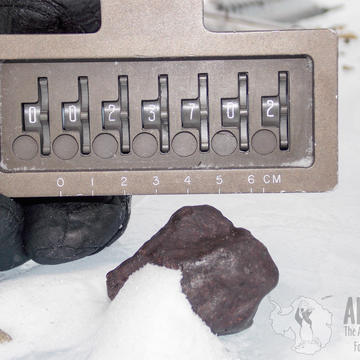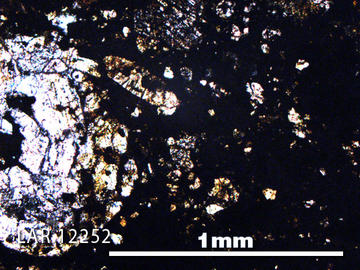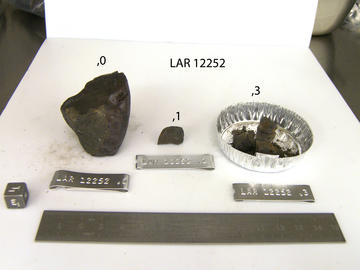Researchers uncover crucial evidence for the origin of water on Earth

The meteorite used in this study - LAR12252 - when it was discovered in Antarctica. Credit: The ANSMET (ANtarctic Search for METeorites) Program, Case Western Reserve University and the University of Utah.
A team of researchers at the University of Oxford have uncovered crucial evidence for the origin of water on Earth. Using a rare type of meteorite, known as an enstatite chondrite, which has a composition analogous to that of the early Earth (4.55 billion years ago), they have found a source of hydrogen which would have been critical for the formation of water molecules. The findings were published today in the journal Icarus.
Crucially, they were able to show that the hydrogen present in this material was intrinsic, and not from terrestrial contamination, which suggests that the material which built our planet was far richer in hydrogen than previously thought. Without this fundamental elemental building-block of water, it would have been impossible for our planet to develop the conditions to support life.
The origin of hydrogen, and by extension water, on Earth has been highly debated, with many believing that the necessary hydrogen was delivered by asteroids from outer space during the first 100 million years of Earth’s history. But these new findings contradict this, suggesting instead that Earth had the hydrogen it needed to create water from when it first formed.
Tom Barrett, Oxford Earth Sciences DPhil student, who led the study, said: “The goal of this research was to expand on the work of a team in France who found that there were large quantities of hydrogen hidden inside enstatite chondrites, which we can use as an analogue for the early Earth. They managed to locate the source of around 20% of the total hydrogen inside organic materials and non-crystalline parts of the meteorite, but were unable to locate the bulk. Without this information, it was uncertain if this hydrogen was just terrestrial contamination.”
To search for the source of the remaining hydrogen, the Oxford team analysed the elemental composition of a meteorite known as LAR12252, originally collected from Antarctica, using an elemental analysis technique called X-Ray Absorption Near Edge Structure (XANES) spectroscopy at the Diamond Light Source synchrotron. They suspected that significant amounts of the hydrogen may be attached to the meteorite’s abundant sulphur. Using the synchrotron, they shone a powerful beam of X-rays onto the meteorite’s structure to search for sulphur-bearing compounds.
“After oxygen, the next most abundant element that bonds to hydrogen is sulphur, and there is an abundance of sulphur in these meteorites. XANES allows us to shine a powerful beam of x-rays onto the meteorite’s structure to search for sulphur-bearing compounds. We were incredibly excited when the analysis told us the sample contained hydrogen sulfide (HS) – but it wasn’t where we expected”
- Associate Professor James Bryson, Study Co-Author

Thin section photo of sample LAR 12252 in plane-polarised light with 5x magnification. Credit: NASA
When initially scanning the sample, the team focussed their efforts on the chondrules (millimetre-sized spherical objects within the meteorite), where hydrogen had been found before. But when serendipitously analysing the material just outside of one of these chondrules, composed of a matrix of extremely fine (sub-micrometre) material, the team discovered that the matrix was incredibly rich in hydrogen sulphide. In fact, their analysis found that the amount of hydrogen in the matrix was five times higher than that of the non-crystalline sections within the chondrules.

Lab photo of sample LAR 12252. Credit: NASA.
In contrast, in other parts of the meteorite that had cracks and signs of obvious terrestrial contamination (such as rust), very little or no hydrogen was present. This makes it highly unlikely that the hydrogen sulphide compounds detected by the team originated from an Earthly source.
Since the proto-Earth was made of material similar to enstatite chondrites, this suggests that by the time the forming planet had become large enough to be struck by asteroids, it would have amassed enough reserves of hydrogen to explain Earth’s present-day water abundance.
“This finding supports the idea that the formation of water on Earth was a natural process, rather than a fluke of hydrated meteorites bombarding our planet after it formed.” says Associate Professor Bryson. “A fundamental question for planetary scientists is how Earth came to look like it does today. We think that the material that built our planet – which we can study using these meteorites – was far richer in hydrogen than we thought previously. As such, we don’t need to evoke external process, like bombardment from hydrated asteroids, to explain the majority of Earth’s hydrogen. This shifts our understanding by allowing habitable conditions on Earth to have been deterministic rather than stochastic”.
“Because the likelihood of this hydrogen sulphide originating from terrestrial contamination is very low, this research provides vital evidence to support the theory that water on Earth is native - that it is a natural outcome of what our planet is made of.”
- Tom Barrett, Study Lead Author
The study ‘The source of hydrogen in earth's building blocks’ was published today in the journal Icarus, and is available to read at https://doi.org/10.1016/j.icarus.2025.116588.




